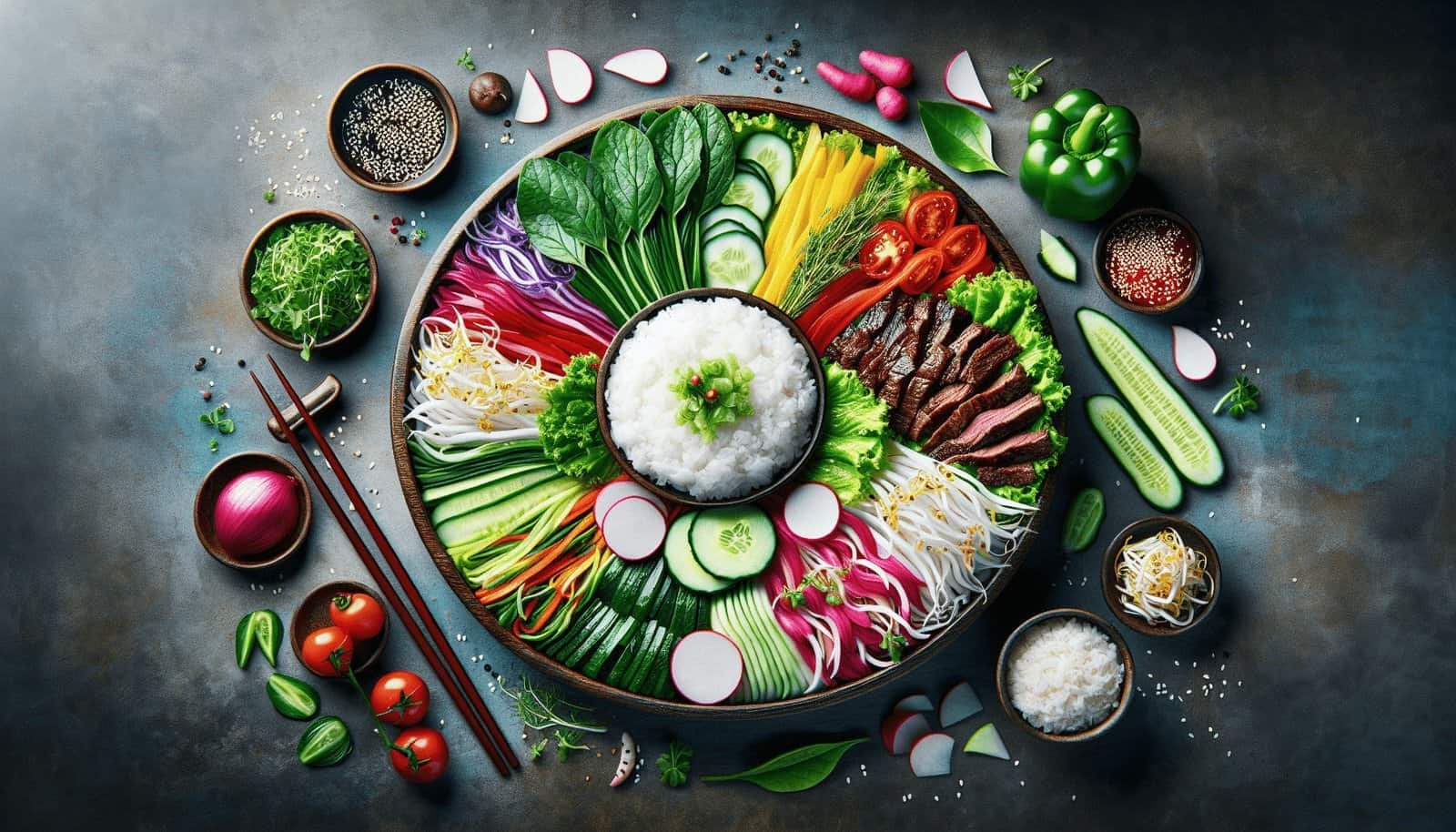Picture this: a colorful array of fresh, flavorful ingredients laid out before you, accompanied by tender, steamed rice. Your mouth waters as you anticipate the explosion of flavors that awaits. This is ssambap, a traditional Korean dish that brings together the best of both worlds – vibrant vegetables and succulent cooked meats. In this article, we’ll take you on a culinary journey through the art of assembling and savoring ssambap, showcasing the traditions and customs that make it such a beloved dish in Korean cuisine. Get ready to embark on a delightful adventure for your taste buds!

Overview
What is ssambap
Ssambap is a traditional Korean dish that consists of a variety of ingredients served with steamed rice and wrapped in lettuce leaves. The term “ssambap” translates to “wrapped rice” in English, which perfectly describes the essence of this dish. It is a refreshing and healthy meal that brings together the flavors and textures of different components, offering a unique dining experience.
Origin of ssambap
Ssambap has its roots deeply embedded in Korean cuisine and has been a staple dish for centuries. It emerged during the Three Kingdoms period and gained popularity amongst the commoners due to its simplicity and affordability. It was enjoyed as a convenient way of consuming nutritious ingredients, allowing individuals to wrap their desired combination of food in lettuce leaves, creating a personalized bite-sized parcel of flavors.
Importance of ssambap in Korean cuisine
Ssambap holds a significant place in Korean cuisine as it represents the country’s cultural heritage and culinary traditions. It showcases the importance of communal dining and sharing, allowing family and friends to gather around the table, assembling their own wraps and engaging in lively conversations. Ssambap also reflects the Korean emphasis on the consumption of fresh and seasonal ingredients, providing a well-rounded and balanced meal.
Ingredients
Main ingredients
The main components of ssambap include steamed rice, protein, and an assortment of vegetables. The protein can range from grilled beef (bulgogi), marinated pork (samgyeopsal), or even tofu for vegetarians. The vegetables often include lettuce, perilla leaves, cucumbers, bean sprouts, radishes, and kimchi. These ingredients offer a harmonious blend of textures and flavors, providing a satisfying and nourishing meal.
Variations and substitutions
One of the remarkable aspects of ssambap is its versatility, allowing for countless variations and substitutions based on personal preferences and dietary needs. For protein alternatives, chicken, seafood, or even mushrooms can be used. In terms of vegetables, spinach, cabbage, carrots, and various herbs can be incorporated to add depth to the wrapping experience. Ssambap truly enables individuals to customize their meal according to individual taste and dietary restrictions.

Preparation
Preparing the rice
The foundation of ssambap lies in perfectly steamed rice. To prepare the rice, rinse it thoroughly under cold water until the water runs clear. Then, place the rice in a pot and add the appropriate amount of water. Allow it to soak for about 30 minutes before bringing it to a boil. Once boiled, reduce the heat to a simmer, cover the pot, and let it cook for approximately 15-20 minutes. Afterward, let it rest for another 10 minutes to ensure fluffy and evenly cooked rice.
Cooking the protein
The protein element of ssambap requires careful attention to achieve a delicious result. For beef or pork, marinate the meat with a combination of soy sauce, ginger, garlic, and other desired seasonings. Allow it to marinate for at least 30 minutes to absorb the flavors. Heat a pan or grill to medium-high heat and cook the protein until it reaches the desired doneness. It is crucial to slice the meat thinly against the grain for optimal tenderness.
Preparing the vegetables
Fresh and vibrant vegetables are integral to ssambap. Begin by washing the lettuce, perilla leaves, and other greens thoroughly. Pat them dry for easier wrapping. For cucumber, radishes, and bean sprouts, blanch them in boiling water for a short time, then immediately place them in an ice bath to retain their crispness and color. Slice the vegetables into thin, manageable pieces that can fit nicely in the lettuce leaves.
Assembly
Preparing lettuce leaves
Lettuce leaves serve as the primary vessel for ssambap, offering a refreshing crunch and a subtle earthy flavor. Carefully separate the leaves, ensuring they remain intact. Rinse them under cold water and dry them gently with a kitchen towel or paper towels. It is essential to remove excess moisture to prevent soggy wraps.
Arranging the ingredients
The beauty of ssambap lies in the freedom to arrange the ingredients according to personal preference. Start by placing a spoonful of steamed rice in the center of each lettuce leaf. Next, add a slice of protein, whether it be beef, pork, or tofu, on top of the rice. Garnish the wrap with an array of vegetables, such as cucumber, radish, bean sprouts, and kimchi. The combination of textures and flavors ensures a delightful eating experience with every bite.
Adding condiments and sauces
To enhance the flavors of ssambap, various condiments and sauces can be added. Some popular choices include gochujang, a spicy and savory red pepper paste, ssamjang, a mixed soybean paste, and doenjang, a fermented soybean paste. These condiments provide a depth of flavor and a hint of spiciness to the wraps. Additionally, sesame oil, garlic, and spring onions can be used to elevate the overall taste.

Enjoyment
Ssambap as a communal meal
Ssambap holds a unique cultural significance in Korean cuisine as it encourages communal dining and fosters a sense of togetherness. It is commonly enjoyed in a group setting where family and friends gather around a table filled with various ingredients. This communal style of eating allows individuals to engage in lively conversations, share their favorite combinations of ingredients, and have a truly interactive and enjoyable dining experience.
Proper eating etiquette
When enjoying ssambap, there are a few proper eating etiquette practices to keep in mind. It is customary to hold the wrap with your hands rather than using utensils. Fold the lettuce leaf securely around the ingredients, making sure it is not overly packed. Take small and manageable bites to savor the diverse flavors in each wrap. It is also respectful to avoid discussing business matters during the meal and instead focus on the pleasure of shared culinary experiences.
Pairing ssambap with other dishes
Ssambap can be enhanced by pairing it with other traditional Korean dishes. Some popular accompaniments include kimchi, a spicy and fermented vegetable side dish, and doenjang jjigae, a savory soybean paste stew. The combination of ssambap with complimentary dishes creates a balanced and complete meal, showcasing the diversity and richness of Korean cuisine. Pairings can vary depending on personal preference and can be tailored to create a cohesive dining experience.
In conclusion, ssambap is a remarkable traditional Korean dish that celebrates the essence of communal dining and the fusion of various flavors. With its flexible nature, ssambap allows individuals to create personalized wraps using a variety of ingredients. From the careful preparation of rice, proteins, and vegetables to the artful assembly and enjoyable dining experience, ssambap reflects the cultural heritage and culinary traditions of Korea. Whether it’s a family gathering or a social event, ssambap brings people together, fostering connections and creating unforgettable memories around the shared joy of food.
